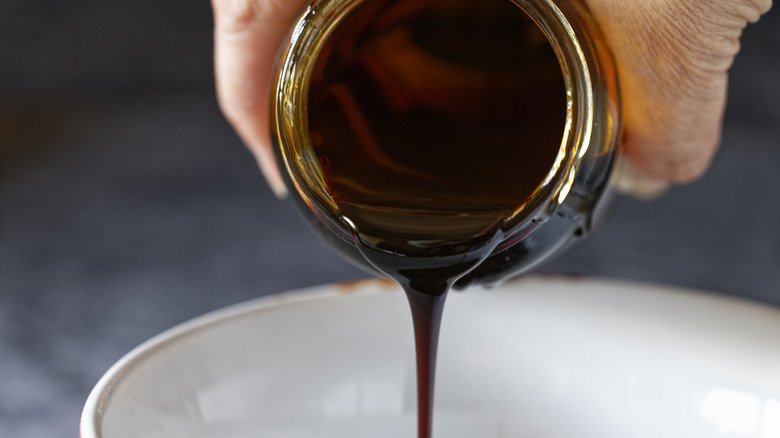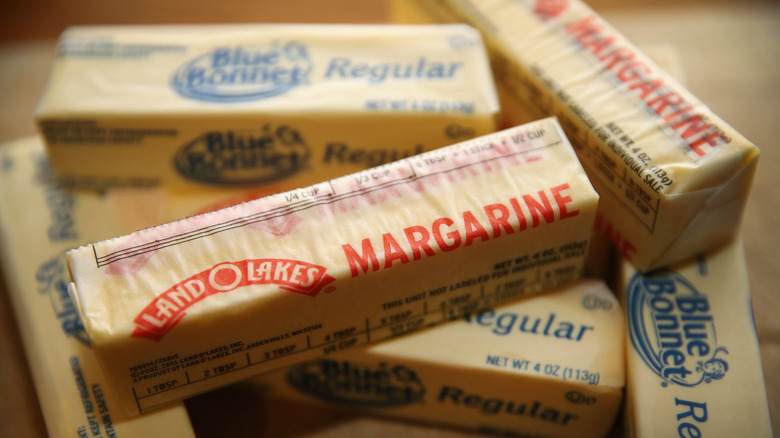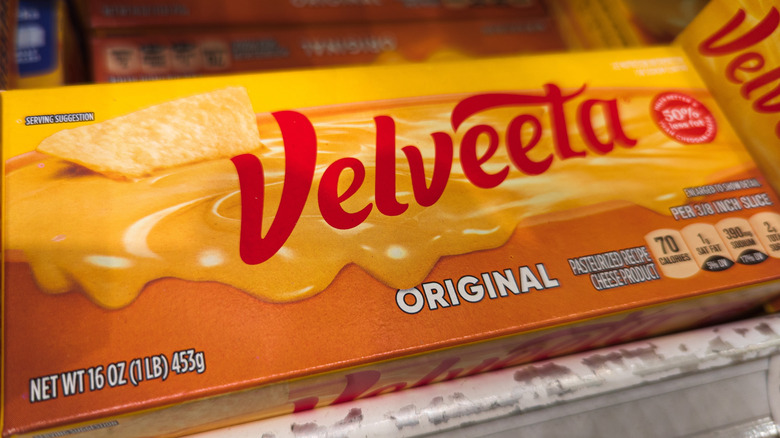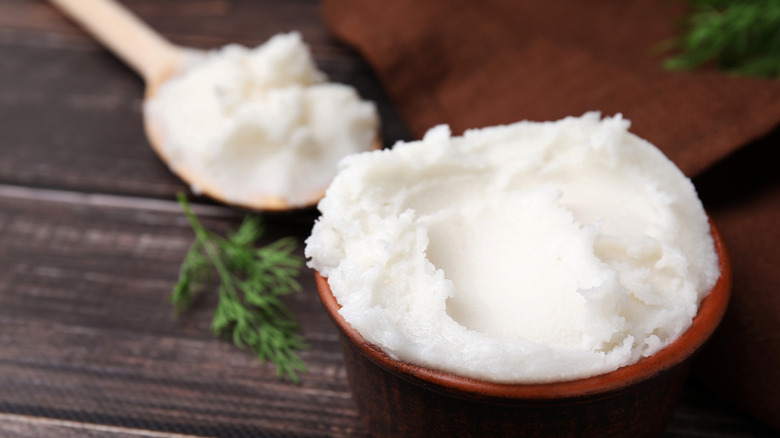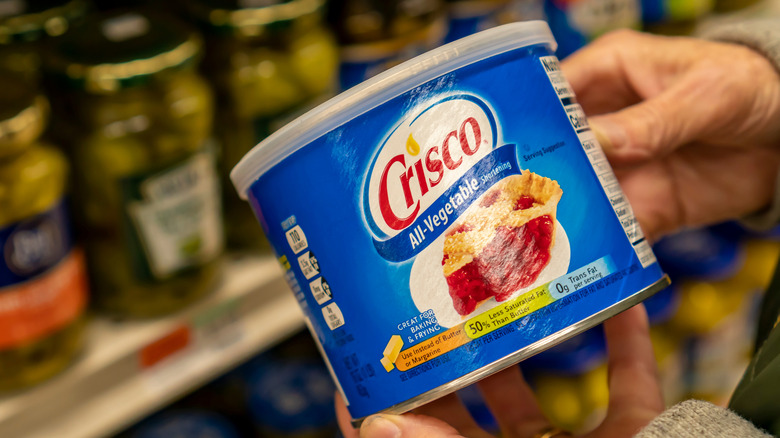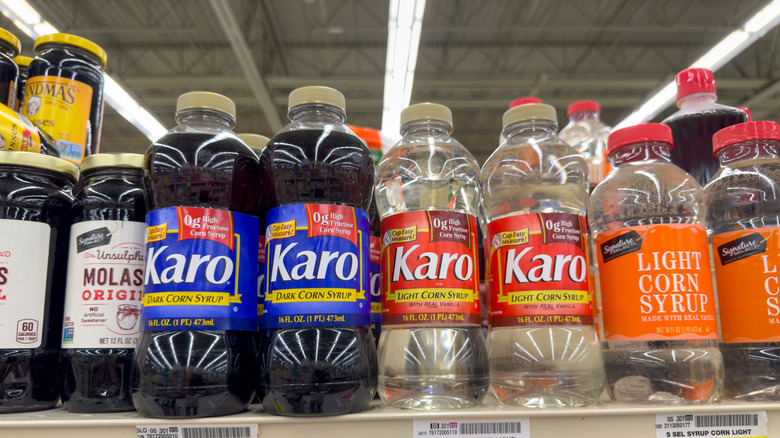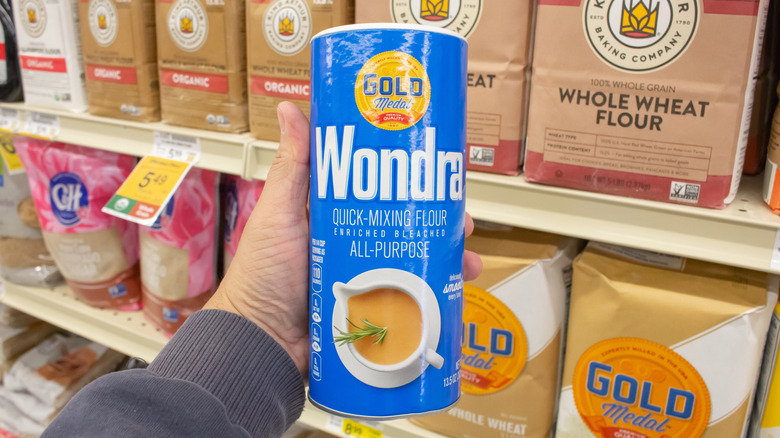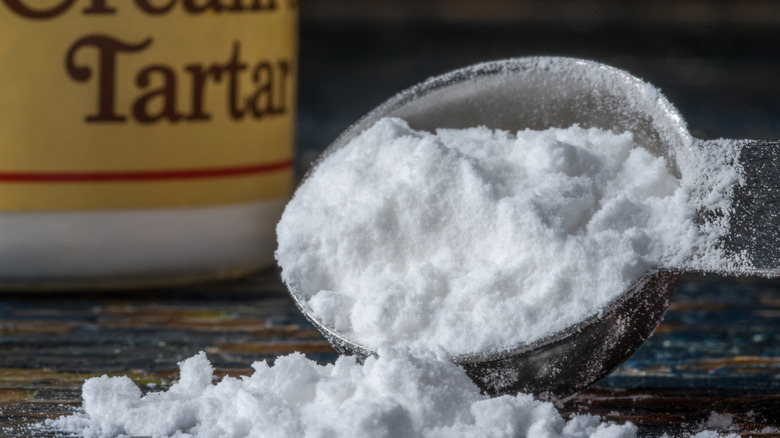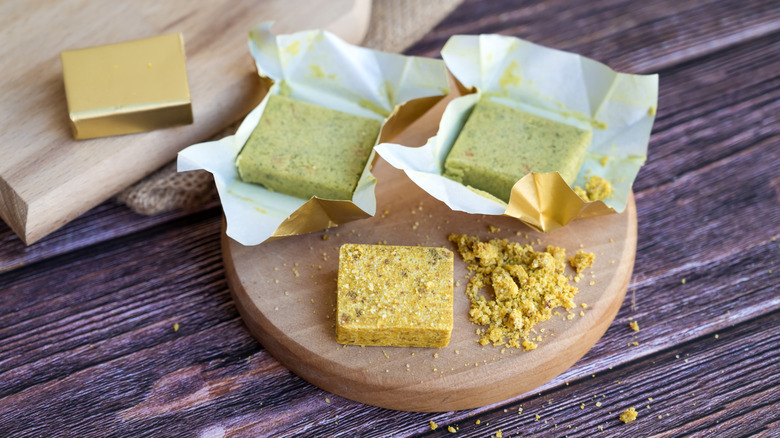12 Vintage Ingredients Grandma Always Cooked With (And Now We Don't)
We may receive a commission on purchases made from links.
Just like fashion, technology, and music styles, culinary trends change with the times. What's making waves in kitchens and restaurants today might be completely forgotten tomorrow. Globalization, innovation, and increased interest in eating healthy food all play a huge role in what we put on our shopping lists and plates.
As culinary preferences and nutritional requirements evolve, many of the ingredients our grandmothers kept stocked in the pantry have quietly fallen out of favor. In many cases, they have become redundant, replaced by more modern and convenient cooking alternatives. In others, they have been sidelined due to health concerns and changing taste preferences. After all, these days not everybody has the appetite — or the time — to make the often labor-intensive vintage recipes in family cookbooks.
Ready to take a deep dive into some of the old-fashioned pantry staples that filled grandma's pantry? Check out our roundup of forgotten ingredients that were once kitchen essentials.
Molasses
Alongside honey, molasses was a common sweetener until World War I, when the price of sugar plummeted, making it more accessible to the average household. A byproduct of the sugar-making process, molasses is produced when sugarcane and sugar beets are boiled to extract their sugar content. In its heyday, molasses was celebrated for its rich flavor, as well as its affordability and nutritional value — the syrup contains calcium, copper, iron, selenium, vitamin B6, and potassium.
As a rule of thumb, molasses comes in three grades. Most commonly used in baking and cooking, light molasses is produced during the first round of boiling, resulting in a sweet, mild-tasting syrup with a relatively high sugar content. A byproduct of the second boil, dark molasses is thicker, darker, and not as sweet as light molasses. Finally, blackstrap molasses is very dark, thick, and somewhat bitter in flavor.
While no longer a pantry staple, molasses remains an ingredient in some more traditional kitchens thanks to its versatility. Mild in flavor, light molasses can be poured over fluffy overnight yeasted buttermilk pancakes, cereal, and oatmeal. Meanwhile, the deep and smoky notes of dark molasses enhance baked goods like gingerbread, giving them a moist and chewy quality. Blackstrap molasses isn't generally used in cooking due to its overpowering flavor.
Margarine
The story of margarine's rise and fall is nothing short of captivating. The plant-based butter substitute dates back to 1869, when it was created by a French chemist, Hippolyte Mège-Mouriés, in response to Napoleon III's call for a cheaper alternative to butter amid war shortages. Initially dubbed "oleomargarine," and made with beef tallow, today's margarine is the product of hydrogenation, a process that allows vegetable oils to be transformed into solids.
Margarine started being sold commercially in the U.S. at the end of the 19th century, a time when butter quality was widely inconsistent. Pretty much an immediate hit, margarine consumption quadrupled from the late 1920s to the 1950s, during which time butter sales dropped by one-third (via Sentient Media).
Despite this surge in popularity, margarine's good run wasn't destined to last. As studies linked trans fats — commonly found in margarine — to heart disease, consumer perception of the product started to shift. Once vilified for its saturated fat content, butter has once again found favor among health-conscious consumers, who are now choosing to stay away from processed foods and trans fats in favor of more natural alternatives.
Suet and beef tallow
Suet and beef tallow both come from the same part of a cow — the fat that surrounds the animal's kidneys. However, what makes these two cooking fats different is their form. White in color and slightly crumbly and dry in texture, suet is raw, unrendered fat. In contrast, beef tallow is the rendered version of suet. More specifically, when suet is simmered on low heat, it turns into liquid fat or beef tallow. Once melted down, beef tallow is strained through a fine sieve to remove any "suet cracklings," or the crisped bits that form as the suet cooks down.
Used in old-fashioned British cooking, suet plays a key role in several traditional recipes, including steamed puddings, jam roly-poly, and traditional sweet mincemeat pies. To cook with suet, it's best to chop it up into small pieces or grate it before incorporating it into dough or other ingredients. Since suet has a relatively low melting point of between 113 and 122 degrees Fahrenheit, it melts only after the batter starts to hold its shape, giving baked goods an airy texture.
White and creamy, beef tallow solidifies once in the refrigerator. Nevertheless, it melts easily when heated, making it ideal for a huge range of recipes. It also has a very high smoke point of 400 degrees Fahrenheit, which is perfect for frying, roasting, and basting. Beef tallow started losing its popularity after the 1950s when health authorities began linking animal fats, or saturated fats, to heart disease. Jumping on the bandwagon of this health trend, even McDonald's stopped using beef tallow for its fries in 1990, choosing vegetable oil instead.
Velveeta
Even though most of us have seen Velveeta on supermarket shelves, the cheesy product isn't as popular as it once was, especially among the younger generations. There is a growing preference for natural — less processed cheeses — options. In other words, cheeses like cheddar, gouda, and brie are today's go-to options for cooking and snacking.
So what exactly is Velveeta and why were our grandmothers so obsessed with it? Velveeta dates back to 1918, when a Swiss cheesemaker who worked for the Monroe Cheese Company in New York first came up with the product by repurposing leftover cheese. In 1923, Velveeta became its own brand under the Velveeta Cheese Company, which Kraft purchased just four years later, in 1927.
Velveeta incorporated both cheese and whey, resulting in a smooth and creamy product that melts evenly, making it perfect for sauces and casseroles. It is also shelf stable, which was a definite bonus in an era when refrigeration wasn't as reliable as it is today. Boosted by Kraft's clever marketing campaigns, Velveeta peaked in popularity between the 1930s and 1950s, with studies conducted in the '30s indicating that two-thirds of Americans favored processed cheese over its natural counterpart.
Lard
Popular in the 19th and 20th centuries, lard is rendered pork fat – especially that from around the kidneys and back of the animal. At the time, it was used in cooking and baking, as well as a spread. Lard was also one of the key contributors to the American economy, with the country exporting 200 million pounds of the fat to the U.K. by 1900. But the popularity of lard wasn't to endure, especially with new products entering the market.
In addition, "The Jungle" by Upton Sinclair, which was released in early 20th century, painted a grisly picture of the lard industry that put many people off. One passage in the book is particularly disturbing: "They worked in tank rooms full of steam, and in some of which there were open vats near the level of the floor [...] their peculiar trouble was that they fell into the vats [...] — sometimes they would be overlooked for days, till all but the bones of them had gone out to the world as Durham's Pure Leaf Lard!" (via NPR).
At the same time that Sinclair was exposing the dark underbelly of meat production in his writing, Procter & Gamble introduced a new fat product called Crisco. The shortening was made through hydrogenation, a new process that transformed vegetable oils into solid fat. By marketing Crisco as the healthier choice to lard, Procter & Gamble was able to convince consumers to switch their culinary preferences. The final nail in lard's coffin probably came in the 1950s, when experts started linking saturated fat — which is abundant in lard — with heart disease.
Crisco
Crisco appeared on supermarket shelves in 1911 as a direct competitor to lard in cooking and baking. Invented by Procter & Gamble as a way of utilizing cottonseed oil — a key material used in soapmaking – Crisco offered a plant-based alternative to traditional animal fats. The new product used hydrogenation to turn liquid cottonseed oil into a solid fat suitable for baking and frying. While this initially seemed like a healthier alternative to animal fat, which was high in saturated fat, the story didn't turn out to be that simple.
The process of hydrogenation, which was so crucial to Crisco's texture and shelf stability, also produced trans fats. While it took scientists some time, by the 1990s they began linking trans fats to increased risks of heart disease and stroke, seriously undermining Crisco's popularity.
Today's Crisco is 100% trans fat-free, however, this hasn't been enough to change the public perception of Crisco as highly processed and unhealthy. In addition, while Crisco is now made with palm, canola, and soy oils, cotton plants were once heavily treated with chemical fertilizers and pesticides, which may have added to consumer concerns.
Corn syrup
Corn syrup is essentially cornstarch that has been broken down into glucose. One of the most popular brands of corn syrup is Karo, which has been around since 1902. Interestingly, in the 1930s, Karo became synonymous with pecan pie after a recipe for the dessert — incorporating Karo corn syrup — was published on the back of the product. Traditionally, corn syrup was also a popular addition to cookies, fudge, glazes, and sauces.
Corn syrup's popularity declined for a number of reasons. First and most notably, corn syrup is often associated with high fructose corn syrup. Used as a sweetener in commercial products such as sodas and bottled sauces, high fructose corn syrup is made by enzymatically converting some of the glucose in regular corn syrup into fructose.
Since high fructose corn syrup is around 55% fructose, and the body has to work harder to break down fructose into glucose, its consumption has been linked to a range of health issues. These include an increased risk of fatty liver disease, obesity, and diabetes, leading high fructose corn syrup to be described as worse than sugar. In addition to its poor public image, many consumers have switched from using corn syrup to more natural alternatives like honey, agave nectar, and maple syrup.
Wondra Flour
Launched in 1963 by General Mills under the Gold Medal brand, Wondra flour is a type of "instant flour" that is extremely fine, almost powdery in texture. Its consistency comes from being pre-cooked and dried, which allows it to dissolve into liquids much faster than regular flour. This quality is precisely what made Wondra flour such a hit in the kitchen. Historically, the flour was a favorite for making smooth, lump-free gravies, sauces, and stews. It's also been commonly used in pancakes, crepes, roux, and batter coating for fried foods.
While Wondra flour has its applications, it's not an all-purpose product. The flour's fine texture makes it unsuitable for baking, which has lessened its appeal among those who prefer multi-use ingredients. Wondra is also pricier than other flour types.
In addition, instant flour can be easily substituted with other products, many of which may already be in your kitchen pantries. For instance, ½ tablespoon of Wondra can be replaced with a full tablespoon of rice flour, or each cup of Wondra can be substituted with ⅔ cup of cassava flour. Tapioca flour works well, too, using the same amount as Wondra. Some other substitutes for instant flour include cornstarch, potato starch, and cake flour.
Spam
While Spam continues to have a cult following in Hawaii and parts of Asia, the canned meat is no longer particularly in vogue in the U.S., losing traction to fresh, unprocessed protein. Made with pork, ham, modified potato starch, sodium phosphates, potassium chloride, and sodium nitrite, it's easy to see why many of today's consumers might be skeptical about Spam's ingredient list. This is hardly surprising, as more shoppers move away from processed foods in favor of organic and minimally processed meats.
So what made Spam so popular in its heyday? Likely short for spiced ham, Spam was invented by Hormel Foods in 1937. The canned meat quickly rose in popularity due to its affordability and long shelf life. Spam didn't require cold storage, which was a major selling point at a time when many households didn't yet have reliable refrigeration.
Despite its many advantages, Spam didn't hit the spotlight until World War II, when 100 million pounds of the protein were shipped to Allied forces around the globe. Notably, at one stage, Span was even celebrated as the meat that won the war.
Cream of tartar
A byproduct of the winemaking process, cream of tartar — or potassium bitartrate — forms as crystals on the inside of wine barrels during fermentation. These crystals (also known as tartrates and beeswing) are then turned into the powder we see at grocery stores. Being an acid, cream of tartar has limited applications in baking — it only works as leavener when paired with alkaline food. It also has a somewhat metallic taste, which may not appeal to some bakers.
Today, cream of tartar has been replaced by more modern leavening agents, like commercial baking powder (which combines cream of tartar and sodium bicarbonate) and self-rising flour. Nevertheless, many still praise the powder for its ability to stiffen egg‑white foams and stabilize sweet meringues. Cream of tartar is also valued in candy-making because it stops sugar from crystallizing, ensuring that syrups and treats like lollipops or caramel remain smooth and glossy.
Gelatin
For anyone who's never heard of it, gelatin is a colorless, flavorless protein derived from collagen. Traditionally sourced from animal tissues such as bones, skin, tendons, and cartilage, solid gelatin takes on a gel-like consistency when dissolved in hot water. This is precisely what makes it such a popular ingredient in treats like jellies, marshmallows, and gummies.
While gelatin has a long history dating back to ancient Egypt, gelatin powder made its American debut thanks to a patent filed in 1845. Gelatin became widely available in the late 1800s, with manufacturers producing it in the form of sheets, blocks, and powders. Perhaps one of the most well-known gelatin products is Jell-O, which was introduced at the end of the 19th century. With its bright colors and wobbly texture, Jell-O became the quintessential American dessert.
With aspics no longer a staple on most menus, gelatin has seen a steady decline in popularity. And it certainly hasn't helped that many consumers have transitioned to vegetarian and vegan diets. While its use commercially continues, the once-celebrated ingredient is no longer a go-to item in most kitchens, with some home cooks opting for substitutes like pectin, guar gum, arrowroot, and cornstarch.
Bouillon cubes
Used to improve the flavor of soups, sauces, and stews, bouillon cubes are small blocks made of dehydrated meat, seasoning, and salt. In cooking, they are dissolved in water to make an instant broth. While dried soups first hit the market in 1873, bouillon cubes took this concept a step further by condensing meat flavor into one-inch squares. Invented by a Swiss food manufacturer, Julius Maggi, bouillon cubes entered the European market in 1908.
The British company Oxo launched its own bouillon cubes two years later, in 1910. During World War I, Oxo sent 100 million bouillon cubes to British troops and began marketing the product both at home and in its colonies. Oxo's early advertising for bouillon cubes claimed that they would improve the flavor of meat dishes, aid digestion, and promote mental and physical health.
It's easy to see why bouillon cubes gained fans around the globe. The foil-wrapped squares replaced the need to make homemade stock from scratch, had a long shelf life, and were very affordable. It's also easy to see why they eventually faded from the spotlight. Bouillon tends to be high in sodium but offers little in terms of nutrition. Also, the availability of more flavorful options like ready-made liquid broths and stock concentrates has substantially reduced the bouillon cube market.

